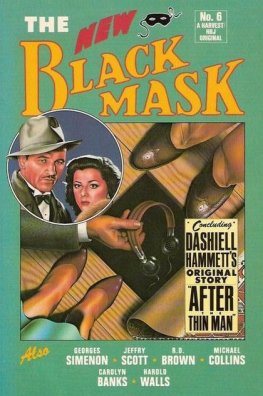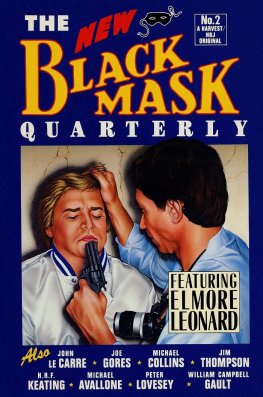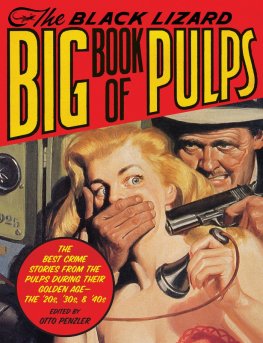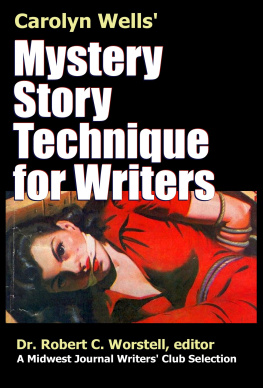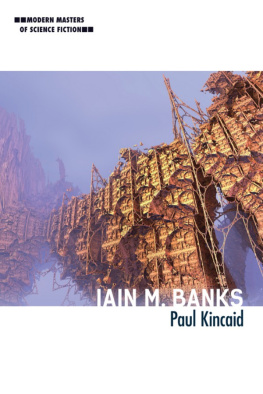Carolyn Banks - The New Black Mask (№6)
Here you can read online Carolyn Banks - The New Black Mask (№6) full text of the book (entire story) in english for free. Download pdf and epub, get meaning, cover and reviews about this ebook. City: New York, year: 1986, publisher: A Harvest/HBJ book, genre: Detective and thriller. Description of the work, (preface) as well as reviews are available. Best literature library LitArk.com created for fans of good reading and offers a wide selection of genres:
Romance novel
Science fiction
Adventure
Detective
Science
History
Home and family
Prose
Art
Politics
Computer
Non-fiction
Religion
Business
Children
Humor
Choose a favorite category and find really read worthwhile books. Enjoy immersion in the world of imagination, feel the emotions of the characters or learn something new for yourself, make an fascinating discovery.
- Book:The New Black Mask (№6)
- Author:
- Publisher:A Harvest/HBJ book
- Genre:
- Year:1986
- City:New York
- ISBN:978-0-15-665485-2
- Rating:4 / 5
- Favourites:Add to favourites
- Your mark:
- 80
- 1
- 2
- 3
- 4
- 5
The New Black Mask (№6): summary, description and annotation
We offer to read an annotation, description, summary or preface (depends on what the author of the book "The New Black Mask (№6)" wrote himself). If you haven't found the necessary information about the book — write in the comments, we will try to find it.
The New Black Mask (№6) — read online for free the complete book (whole text) full work
Below is the text of the book, divided by pages. System saving the place of the last page read, allows you to conveniently read the book "The New Black Mask (№6)" online for free, without having to search again every time where you left off. Put a bookmark, and you can go to the page where you finished reading at any time.
Font size:
Interval:
Bookmark:
The New Black Mask ( 6)
Georges Simenon: An Interview, copyright 1986 by Georges Simenon. The Man Behind the Looking Glass, originally published as La cage dEmile, by Georges Simenon, copyright 1943, Editions Gallimard, translated by Harold J. Salemson, copyright 1986. After the Thin Man, by Dashiell Hammett, copyright 1986 by MGM/UA Entertainment Co. A Friend to the Limit, copyright 1986 by Jeffry Scott. Frisbee in the Middle, copyright 1986 by R. D. Brown. Mean to My Father, copyright 1986 by Carolyn Banks. Killers Mind, copyright 1986 by Michael Collins. It Was a Hard Fall, copyright 1986 by Harold Walls.
Georges Simenon: An Interview
Simenon (he long ago reached the level of eminence that renders honorifics superfluous) was born in Lige, Belgium, in 1903, and writes in French. His most famous creation, Inspector Maigret, first appeared in 1931; but the many Maigret stories account for a relatively small portion of the bountiful Simenon canon. His work is superbly readable because among other qualities of its economy and pace. He has pared his prose to its essentials. Beyond readability, he provides accurate observation of behavior: what his characters do is what they are.
Simenon agreed to answer questions for New Black Mask in writing, explaining: I am in the habit of writing short. But I am incapable of long dissertations.
NBM: Certain critics insist that every great novelist has his own narrative voice, and that this voice provides the defining quality of his prose. If you agree with this claim, please describe your prose voice. Is it consistent or does it vary with the different types of your novels?
Simenon: Naturally, every novelist has his own style. I have always tried to make mine as simple as possible, with a minimum of adjectives and adverbs, a minimum of abstract words which have a different resonance for each reader. I use a maximum of mots matire.
The rhythm alone varies according to the subject, sometimes from one chapter to another.
NBM: Are your characters lives determined by forces hereditary and environmental over which they have no control? Or do you allow them the chance to alter their destinies?
Simenon: Very few people are capable of changing their destinies, but heredity, environment, and even climatic conditions play an important part in human behavior. A discussion between husband and wife on a lovely spring day will not have the same violence as in oppressive and thundery weather.
NBM: You have said that the purpose of your revisions is to remove the literary sentences. Yet you admire William Faulkners work. Isnt he a highly literary writer?
Simenon: Faulkner was not considered as such when he started, so much so that he had to work in Hollywood to make a living, and if he was largely published and acclaimed in France, he had to discuss no end with his American publishers.
Style is the reflection of man, and Faulkner was a most complicated person. Fortunately for us.
NBM: Most of your worldwide readers know your work only in translation and so have read Simenon filtered through someone else. What rules would you like your translators to obey?
Simenon: To safeguard my simplicity. Which is difficult, as for instance in Italian.
NBM: Are there elements in your work that are untranslatable?
Simenon: It depends on the languages... and on the translators.
NBM: What qualities should your ideal reader possess?
Simenon: To read without trying to analyze.
NBM: When you were writing a novel, were you consciously aware of technique or did the material shape your technique?
Simenon: I have always searched after simplicity. Boileau wrote: When you want to say it rains, say: It rains.
NBM: Did you see your characters faces as you wrote about them? Did you deliberately collect or save the faces that you observed?
Simenon: I have collected, or rather, unconsciously recorded, living characters which I used, sometimes years later.
NBM: As the most widely read living author, do you feel that your work has universal qualities? If so, what are the qualities that cut across the borders, languages, and cultures?
Simenon: Simplicity? Sincerity? I just dont know.
NBM: If you were beginning your career in 1985 what kinds of novels would you try to write?
Simenon: I dont know. Probably the same.
The Man Behind the Looking Glass
Georges Simenon
Translated by Harold J. Salemson
This marks the first publication in English of The Man Behind the Looking Glass. The story was published as La cage dEmile in Simenons Les Dossiers de lAgence O (Paris: Gallimard, 1943).
I
In which young lady swoons in the arms of sturdy Torrence, and in which we learn of the strange chain of command at the Agency.
Eleven A.M. The viscous fog to which Paris awakened is the kind you can tell wont dissipate all day. The young lady has had her taxi stop in the Rue du Faubourg Montmartre, and dashes briskly into the Cit Bergre. There must be a rehearsal going on at the Palace Theater, for two or three dozen showgirls and chorines are pacing back and forth on the sidewalk outside.
Directly across from the stage door of the famous musical-revue theater, a hairdressers shop, its facade painted a gaudy purple: Chez Adolphe.
To the right, a small door, a dark corridor, a stairway with no concierge to stop you. An enamel nameplate, these words in black on white: Agency O, Third Floor Left.
The greatest of stage stars have gone through the portals across the street, and famous politicians, princes of royal lineage, and multimillionaires have been familiars of the Palace backstage.
How many of these same personalities, on mornings like this one, also sneaked in here, collars turned up, hats hiding their faces, up the stairs to Agency O?
At the third floor, the young lady stops for a moment and takes a mirror from her handbag. But not to check on her makeup. On the contrary, as she looks at herself, her face takes on an even more haunted expression.
She rings. A slow step is heard inside. The door is opened by a most unprepossessing clerk. The waiting room looks tacky. A newspaper on a small table. No doubt the clerk was just reading it.
I would like to see the manager, she says excitedly. Would you please tell him its terribly important...
And she dabs at her eyes with her handkerchief. The clerk must have seen many more like her, for he turns without hurry toward an inside door, disappears, comes back a little later, and just motions to her.
The next minute, the girl goes into the office of Joseph Torrence, a former inspector of Paris Criminal Division, now manager of Agency O, one of the most famous private detective agencies in the world.
Please come in, mademoiselle, he says. Have a seat.
Nothing could look more ordinary than this office in which so many terrifying secrets have been revealed. Nothing could be more reassuring than big old Torrence, an easygoing giant of a man in his late forties, looking very well groomed and well fed.
The window that looks out on the Cit Bergre has opaque panes. The walls are lined with bookshelves and files. Behind the mahogany desk, within Torrences easy reach, the kind of safe you might find in any business office anywhere.
Excuse me, monsieur, if I seem a little nervous. You will understand, as soon as I fill you in... Were all alone here, arent we?... I have just arrived from La Rochelle. All that happened there was just...
She has not sat down. She paces back and forth. She folds and unfolds her handkerchief, obviously racked by the most extreme agitation, while Torrence methodically goes on filling his pipe.
At that point, a door opens. A tall redheaded young man, who seems to have grown too fast so that his suit has become too small on him, enters the room, notices who is there, apologizes, and says, Oh, excuse me, boss.
Font size:
Interval:
Bookmark:
Similar books «The New Black Mask (№6)»
Look at similar books to The New Black Mask (№6). We have selected literature similar in name and meaning in the hope of providing readers with more options to find new, interesting, not yet read works.
Discussion, reviews of the book The New Black Mask (№6) and just readers' own opinions. Leave your comments, write what you think about the work, its meaning or the main characters. Specify what exactly you liked and what you didn't like, and why you think so.

